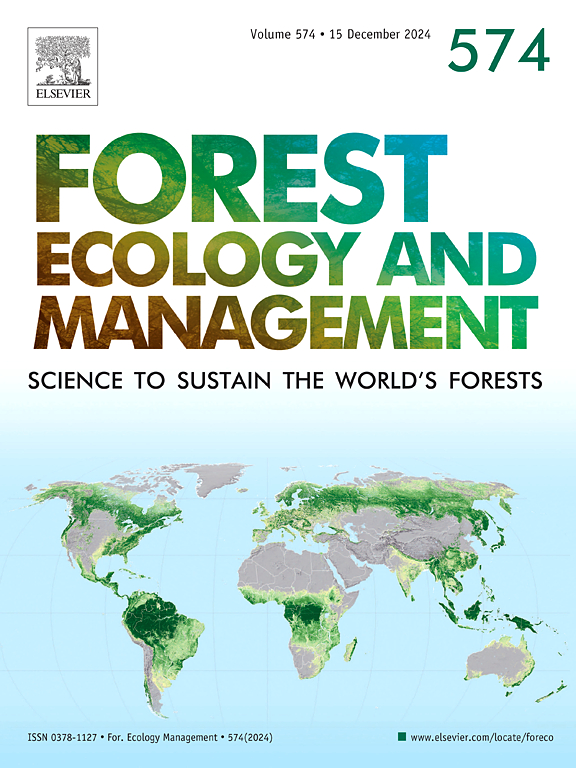Multi-scale environmental drivers of lichen diversity: Insights for forest management
IF 3.7
2区 农林科学
Q1 FORESTRY
引用次数: 0
Abstract
Global change drivers, including fragmentation, climate change and habitat degradation, are accelerating the alarming decline in biodiversity worldwide. Additionally, biodiversity-environment interactions may vary depending on the spatial scale, as communities are shaped by both large- and small-scale factors. Therefore, it is crucial to assess the taxonomic, functional and phylogenetic responses of communities to environmental factors operating at different scales. To address this, we investigated epiphytic lichen communities thriving in 20 oak forest fragments located between temperate and Mediterranean climates in the northwest of the Iberian Peninsula. Using structural equation modelling, we tested the effects of forest fragmentation, climate, habitat structure and quality on functional (FD), taxonomic (TD) and phylogenetic (PD) diversities at plot and tree scales, considering both direct and indirect effects mediated through FD. Our findings indicate that habitat structure and climate are key determinants of diversity at both spatial scales. Additionally, habitat quality emerged as a critical predictor exclusively at the tree scale. Heterogeneity in habitat structure had a profound effect on diversity, increasing FD, TD and PD, while climate primarily influenced TD. Conversely, habitat quality positively affected both FD and TD, but its net effect on PD was negative. Although TD can be inferred through PD, FD emerged as the cornerstone mediating between the environment and other diversity facets. However, direct relationships were also identified. These results highlight the necessity of incorporating multi-scale and multi-faceted approaches in forest management practices. Effective forest management should monitor and manage key factors such as slope and DBH to enhance FD, TD, and PD of lichens. By focusing on these factors, forest management can ensure the resilience and sustainability of forest ecosystems, promoting biodiversity conservation and ecosystem services in the face of global environmental changes.
求助全文
约1分钟内获得全文
求助全文
来源期刊

Forest Ecology and Management
农林科学-林学
CiteScore
7.50
自引率
10.80%
发文量
665
审稿时长
39 days
期刊介绍:
Forest Ecology and Management publishes scientific articles linking forest ecology with forest management, focusing on the application of biological, ecological and social knowledge to the management and conservation of plantations and natural forests. The scope of the journal includes all forest ecosystems of the world.
A peer-review process ensures the quality and international interest of the manuscripts accepted for publication. The journal encourages communication between scientists in disparate fields who share a common interest in ecology and forest management, bridging the gap between research workers and forest managers.
We encourage submission of papers that will have the strongest interest and value to the Journal''s international readership. Some key features of papers with strong interest include:
1. Clear connections between the ecology and management of forests;
2. Novel ideas or approaches to important challenges in forest ecology and management;
3. Studies that address a population of interest beyond the scale of single research sites, Three key points in the design of forest experiments, Forest Ecology and Management 255 (2008) 2022-2023);
4. Review Articles on timely, important topics. Authors are welcome to contact one of the editors to discuss the suitability of a potential review manuscript.
The Journal encourages proposals for special issues examining important areas of forest ecology and management. Potential guest editors should contact any of the Editors to begin discussions about topics, potential papers, and other details.
 求助内容:
求助内容: 应助结果提醒方式:
应助结果提醒方式:


